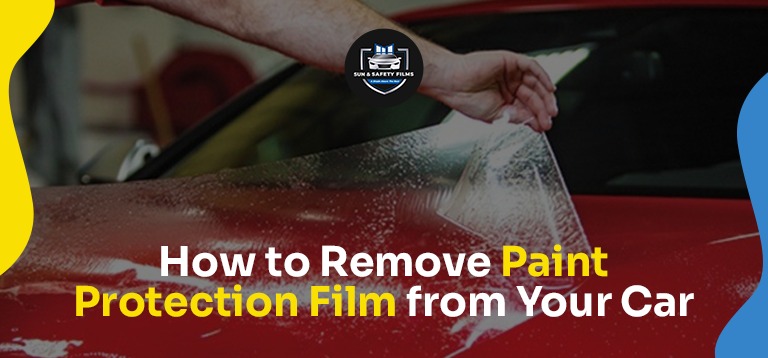Removing paint protection film (PPF) from your car can seem daunting, but with the right approach and tools, you can do it yourself with minimal risk to your vehicle’s paintwork. PPF is designed to protect your car’s paint from scratches, UV rays, and other environmental hazards, but over time, it may need to be replaced due to wear or discoloration.
This guide will walk you through the process and offer tips to ensure you remove the film safely and efficiently.
Why Remove Paint Protection Film?
Car Paint protection film is an excellent investment for maintaining your car’s appearance, especially in harsh environments.
However, there are several reasons you might need to remove it:
- Aging or Yellowing: Over time, PPF can discolor, especially if it was not of high quality or properly maintained.
- Peeling or Bubbling: Poor installation or age can cause the film to peel or bubble, which looks unsightly and compromises the protection it provides.
- Reselling or Leasing: If you plan to sell or return your vehicle at the end of a lease, you may need to remove the film to restore the car to its original condition.
Removing the film correctly is essential to avoid damaging your car’s paint.
Tools You’ll Need
Before you begin, gather the following tools:
- Heat Gun or Hair Dryer: To soften the adhesive and make the film easier to remove.
- Plastic Razor Blade or Plastic Scraper: To gently lift the edges of the film without scratching the paint.
- Adhesive Remover: A product specifically designed for automotive use, such as Goo Gone or 3M Adhesive Remover.
- Microfiber Cloths: These are used to clean and polish the surface after film removal.
- Car Wash Supplies: Soap, water, and a sponge to clean the car before and after removal.
Step-by-Step Removal Process
Clean the Surface
Before you start, wash your car thoroughly to remove any dirt, dust, or debris. This prevents scratches on the paint when you begin to peel off the film.
Warm the Film
Using a heat gun or hair dryer, gently heat the section of the film you want to start with. Keep the heat source moving to avoid overheating and damaging the paint. The heat will soften the adhesive, making it easier to lift the film.
Lift the Edge
Once the film is warm, gently lift one corner with a plastic razor blade or scraper. Be patient and avoid using too much force, which could tear the film or damage the paint. If the film is resistant, apply more heat.
Peel Off the Film
With the edge lifted, slowly peel the film back. Work in small sections, heating the film as you go. Pull the film at a 45-degree angle to reduce the risk of leaving adhesive residue behind. If you encounter resistance, apply more heat to soften the adhesive.
Remove Residual Adhesive
After removing the film, you may notice some adhesive residue on the paint. Apply an adhesive remover to a microfiber cloth and gently rub the area until the adhesive is gone. Follow the manufacturer’s instructions for the adhesive remover to avoid damaging your car’s paint.
Clean the Surface Again
Once all the film and adhesive have been removed, wash your car to remove any remaining adhesive remover or residue. This will leave your paint clean and ready for waxing or reapplication of a new protective film.
Polish and Protect
Finally, consider polishing your car’s paint to restore its shine and protect it from future damage. If you plan to apply a new PPF, ensure the surface is completely clean and dry before proceeding.
Common Mistakes to Avoid
- Using Metal Scrapers: Metal tools can scratch your paint, leading to costly repairs. Always use plastic tools designed for automotive use.
- Overheating the Film: Applying too much heat can damage your paint. Keep the heat source moving and avoid prolonged exposure to one area.
- Rushing the Process: Removing PPF requires patience. Pulling the film too quickly can leave adhesive behind or damage the paint.
- Skipping the Wash: Failing to wash your car before and after removing the film can result in scratches or contaminants on the paint.
When to Seek Professional Help
While removing PPF is a task that many car owners can handle themselves, there are situations where professional help is recommended:
- Extensive Damage or Discoloration: If the film is severely damaged or has been on the car for many years, it might be more difficult to remove without causing damage.
- Complex Curves or Edges: Removing the film without professional tools and experience can be challenging if your car has complex curves or edges.
- High-Value Vehicles: If you own a luxury or classic car, having a professional handle the removal may be worth the investment to ensure the paint is preserved.
Reapplying Paint Protection Film
Once the old film is removed, you should reapply a new layer of protection. Companies like Sun and Safety Films offer high-quality car paint protection films that can help keep your car looking new. For those in the UAE, considering a Car Paint Protection Film in Dubai is an excellent option to protect your vehicle from the harsh desert climate.
Consider thickness, clarity, and UV resistance when selecting a new film. Professional installation ensures the film is applied correctly and provides maximum protection.
The Final Touch for a Flawless Look
Removing paint protection film from your car requires care and patience, but with the right tools and techniques, it can be done successfully without damaging your paint. Whether you’re preparing to reapply for a new film or simply want to restore your car’s original finish, following these steps will help you achieve the best results.
And if you’re in Dubai, consider investing in a high-quality Car Paint Protection Film from Sun and Safety Films to protect your car for years.



